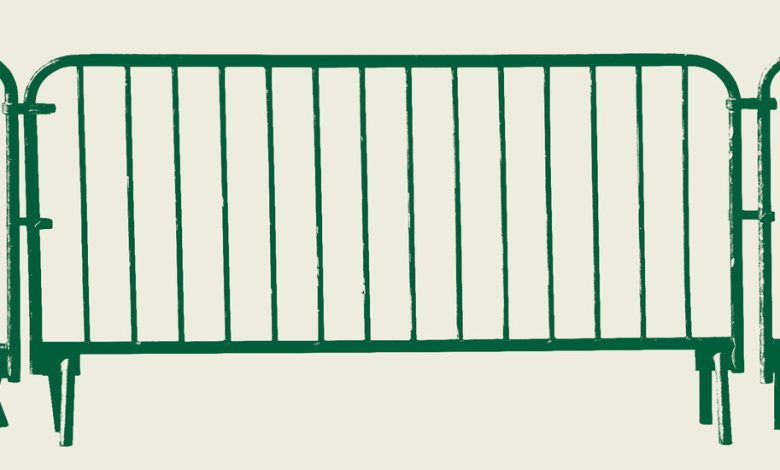Campus Protests Aren’t Going Away. Colleges Need to Draw Lines.

Student protests across the country continue to escalate, leading to mass arrests and police action.
In this conversation with politics editor Sarah Wildman, the Times Opinion columnist David French argues that while free speech needs to be upheld and even encouraged on campuses, there’s a line between civil disobedience and lawlessness, and universities need to clearly articulate where that line is.
Below is a lightly edited transcript of the audio piece. To listen to this piece, click the play button below.

Campus Protests Aren’t Going Away. Colleges Need to Draw Lines.
David French on the role institutions of higher learning must play in campus activism.
Sarah Wildman: I’m Sarah Wildman, a staff editor and writer for Times Opinion.
Campus protests and rallies have been percolating since Oct. 8, but in the past week, something shifted.
Sarah Wildman: It seems on and off campus, the idea of what kind of protest should and should not be allowed is an open question. So I wanted to talk to my colleague David French. He recently wrote about this dilemma and what universities should be doing.
David is an opinion columnist. He’s a lawyer who spent most of his career defending free speech and religious freedom. He’s defended countless protesters, and he has been the subject of protest himself.
David, thank you so much for joining me.
David French: Well, thanks so much for having me, Sarah.
Sarah Wildman: In your recent column, you note that universities are meant to be the “sponsor of critics … not … the critic.” What does that mean?
David French: Schools that are bound by the First Amendment or adopt First Amendment-like principles as many private universities do should be neutral towards the expression of the protesters on campus.
They should be focused on granting equal access, equal rights to various sides of campus disputes. And one of the dangers you see with many of these encampments is their very existence crowds out other voices, and that’s one of the reasons why universities have implemented “time, place and manner restrictions” so that everyone has equal access to the quad, for example, or everyone has equal access to the public forums on campus.
Sarah Wildman: Does that mean you would support forcibly removing the encampments?
David French: Well, there are circumstances in which removing the encampments is necessary to ensure equal access to campus. These are legal responsibilities that the university has.
For example, if one set of students are occupying part of the campus that is normally open to other students as well, and other students are seeking to use that — as they have a right to do under the law — if the university is allowing the encampment to maintain, it can actually be violating the law itself.
Then if the encampment becomes a home of, for example, some vicious antisemitic speech, then it starts to get into the neighborhood of potential civil rights violations. And so, in some circumstances, I don’t think the law gives them much choice but to remove some of these encampments.
Sarah Wildman: Before we go deeper into this moment and the specificities of what’s happening on campuses across the country, I wanted you to take us back to your first experience with campus protest.
David French: Absolutely. It was my first year of law school. I went to a small Christian college in Nashville. And although a lot of my classmates had a lot of political feelings, it was just not a culture given to protest at all. And so I had never encountered it.
And I remember I’m studying in one of my first weeks of law school and I heard drums outside and I had no idea why. And I went out and I saw my first campus protest. It was a protest over faculty diversity at Harvard Law School in 1991. This was an issue that had really divided the campus. I watched a group of students get together and have a pretty raucous protest in front of our library, lots of angry speeches. There was dancing, there was chanting, there was drumming. People were angry, but it was all clearly just a free speech activity. It was all quite clearly exactly the kind of conduct that would be encompassed by the First Amendment.
And I remember being fascinated by it all and interested in quite a few of the campus protests. But they also took a much darker turn at times where the protests would get more aggressive, that protest movements would extend to the classroom to the extent that you would shout down other students to prevent them from being heard. There were disruptive occupations of the administration building.
So I saw the good, the bad and the ugly of campus protesting during my time in law school. And that experience helped launch my free speech career.
Sarah Wildman: In your most recent column, you identify the moment we’re in as one of lawlessness versus civil disobedience. That, to me, seems pretty gray. How are we defining lawlessness versus civil disobedience?
David French: One of the elements of civil disobedience is the person who participates in the act of civil disobedience accepts the consequences of the act.
In other words, things like we saw at Columbia, where people are trying to block access to the police that are trying to clear an encampment that is no longer lawful, or when you are masking and covering your face and perhaps breaking into buildings or blocking access so that students cannot go to classes — when civil disobedience starts to interfere with the rights of others, it is transgressing the bounds. When individuals are refusing to accept the consequences of breaking the law, it is transgressing the bounds.
So civil disobedience is not a license to do what I want, to whom and however I want, as long as it’s for a good cause. That’s not what civil disobedience is.
Sarah Wildman: It seems to me, though, that protests throughout time and certainly within the last 50 years of American history have often had the goal to disrupt. How does that fit into an idea of civility as you describe it?
David French: What I go back to when I think about protests — that is destructive versus protest that is constructive — is protests should not violate other people’s rights. When you’re violating other people’s rights through your protest, you are crossing red lines at that point.
And what I have seen many people do is, if they have sympathy for the underlying cause that the protesters are pursuing, they’ll often make a lot of excuses for the violation of other people’s rights. They’re more sympathetic to it.
But then if they strongly disagree with that cause, then they’re able to see with quite extreme clarity how much that protest is destructive and disruptive. And so one thing that I would ask people to do when they’re evaluating protests is immediately ask, how would you react to that protest if it was coming from somebody with whom you had strong disagreements? Would you see this as constructive, or would you see this as extremely destructive?
I prefer to take a wider look and say, “Is this protest violating other people’s rights?” And if so, it is this responsibility of the government to ensure that we all can exercise our rights.
Sarah Wildman: Are the lines drawn differently when protest is so closely aligned with student identities? You’ve mentioned antisemitism. We haven’t really dug in on why you have. Does it change the nature of how we see this protest if it’s aligned with specific student identities?
David French: So there are really two separate sort of legal strands here. One is, are there identity-based attacks on Jewish students on campus to such an extent that it arises to the level of harassment under federal law, is one set of questions.
Then there’s another set of questions that says, does occupying this quad, does the nature, the time, or the place or the manner of the protest that I’m engaged in, is it actually violating the free expression rights or the equal access rights of other students, regardless of their identity?
So, identity does matter as a matter of federal law, but when it comes to First Amendment analysis, it doesn’t matter as much.
Sarah Wildman: Is this about a failure of control?
David French: Well, it’s about a failure to enforce reasonable time, place and manner restrictions. I don’t know if you would call that control so much as rule of law.
The reasonable time, place and manner restrictions are designed to allow all members of a community to have the same rights within the community. And so, one of the problems that you have is a lot of campus administrators don’t want to do the hard thing. And so they hope the problem goes away, but it doesn’t. It becomes a much harder thing and then a much harder thing until it becomes almost an impossible thing to deal with.
Whereas by taking decisive action early when you see the first violations of these time, place and manner restrictions, you can prevent a problem from escalating to the extent that we’ve seen at Columbia and other schools.
Sarah Wildman: You mentioned Columbia — there you’re seeing some professors outwardly supporting, speaking out about, even protesting themselves, and the administration seen as suppressing. Does that tension create chaos?
David French: The university members of the faculty, they have their own academic freedom rights. They have their own free speech rights. But they also have their own legal obligations, both as members of the community and members of the faculty. And so, one of the things you want to protect when you are talking about free speech on campus is faculty free speech on campus. But if faculty engages in civil disobedience, it should accept the consequences. If faculty participates in protest that violates the rights of others, then it should accept the consequences of that as well.
Sarah Wildman: This goes back to this question of what a university’s role should be in campus activism. I was thinking about this in terms of words like neutral, supportive, incorporating, even promoting activism in some way. Is there a role the university plays other than providing a forum where both sides or many sides can discuss?
David French: Universities have their own institutional academic freedom. So a university does have the academic freedom to say, “OK, we’re going to fly a Palestinian flag. We’re going to condemn Israel’s incursion into Gaza.” A university institutionally can engage in boycotts and divestment. But if they take a single dime of federal dollars, they cannot refuse to protect any identity group from harassment covered by federal anti-discrimination law.
Sarah Wildman: You wrap up your piece by noting that the issues aren’t going away.
David French: No.
Sarah Wildman: And next fall, we may, unfortunately, still be seeing conflict in the Middle East. What’s the best-case scenario for campuses going forward?
David French: I think that a lot of campus administrators need to read some of the statements that I have seen come out of, for example, University of Chicago, where lines are clearly drawn: We will protect free speech. We will permit all voices to protest. We will protect faculty academic freedom. But the instant that your protest violates the rights of others is when it is too far. That language has to be clearly, clearly communicated from Day 1 of the fall semester, and then the university has to walk the talk.
So when the encampments come up, the message has to be “Zero disruptions are permitted, discipline will commence.” And that kind of approach, you’re protecting the rights of free speech, but you’re also protecting the rights of others to access the campus.
Sarah Wildman: David, thank you so much for joining us today.
David French: Thanks so much, Sarah. Really appreciated the conversation.

Credit…Illustration by The New York Times; Photograph by abentson/Getty Images
Thoughts? Email us at [email protected].
This episode of “The Opinions” was produced by Vishakha Darbha and Jillian Weinberger. It was edited by Alison Bruzek and Kaari Pitkin. Mixing and original music by Sonia Herrero. Fact-checking by Mary Marge Locker. Audience strategy by Kristina Samulewski and Shannon Busta.
The Times is committed to publishing a diversity of letters to the editor. We’d like to hear what you think about this or any of our articles. Here are some tips. And here’s our email: [email protected].
Follow the New York Times Opinion section on Facebook, Instagram, TikTok, WhatsApp, X and Threads.



